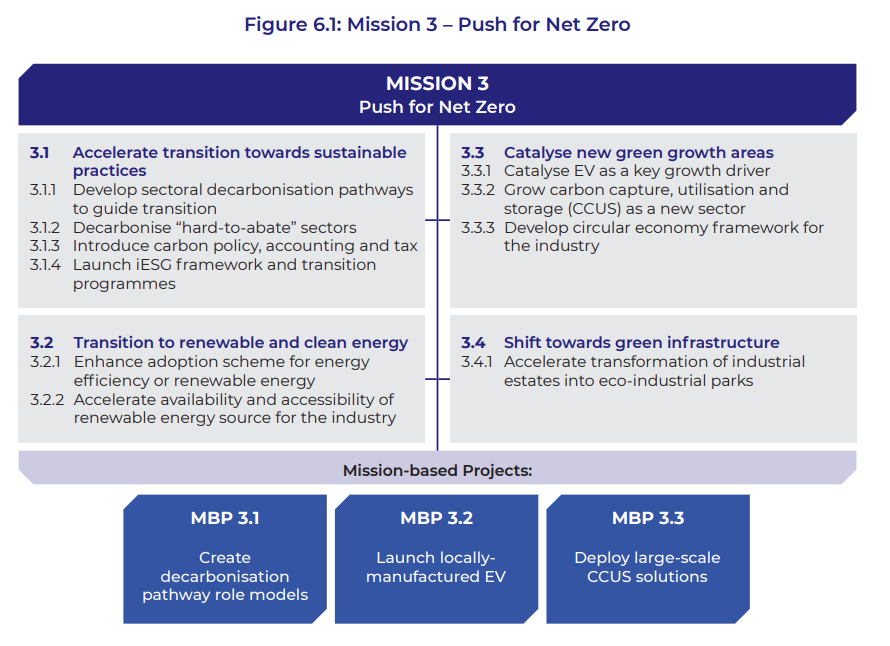
(From left): Miti chief secretary Datuk Isham Ishak, Deputy Prime Minister Datuk Seri Ahmad Zahid Hamidi, Prime Minister Datuk Seri Anwar Ibrahim, Minister of International Trade & Industry Tengku Datuk Seri Utama Zafrul Tengku Abdul Aziz, and Deputy Minister of International Trade & Industry Liew Chin Tong, at the launching of Miti’s National Industrial Master Plan (NIMP) 2023 on Friday, Sept 1, 2023. (Photo by Suhaimi Yusuf/The Edge)
KUALA LUMPUR (Sept 4): One of the six goals of the New Industrial Manufacturing Plan (NIMP) 2030 that was released last Friday (Sept 1) is to enhance ESG (environment, social and governance) practices in Malaysia’s manufacturing sector.
This is meant to de-risk the economy against ESG factors, increase Malaysia’s attractiveness as an investment destination, and ensure Malaysia’s exporters enjoy continued access to ESG-sensitive markets.
Additionally, by driving green manufacturing practices and transitioning towards net zero emissions, Malaysia can position itself as a leader in green solutions and develop new growth sectors.
A total of 10 action plans and three mission-based projects were identified in the NIMP 2030 in relation to this goal.
The action plans include accelerating the transition towards sustainable practices, especially in sectors that find it hard to reduce emissions, such as cement, metal, chemical and petroleum.
Decarbonisation pathways will be co-developed with industry players, and sectoral emissions levy for hard-to-abate sectors will be explored, among other matters.
A carbon policy will be introduced, which sets mandates and guidelines for a carbon accounting model to guide industry players to report their carbon emissions. It will also enable the implementation of a carbon pricing mechanism such as carbon taxes.
Meanwhile, an iESG framework is expected to be introduced to support manufacturing firms to adopt ESG practices. The framework will be aligned with ongoing global reporting standards and aided by tools such as the Simplified ESG Disclosure Guide for SMEs by the Securities Commission Malaysia and Capital Markets Malaysia.
More schemes to encourage energy efficiency and the adoption of renewable energy will be introduced.
The trend towards ESG globally presents opportunities for growth, which the NIMP 2030 also covers.
Three action plans were highlighted in the document, covering the EV (electric vehicle) ecosystem, carbon capture, utilisation and storage (CCUS), and a circular economy framework for the industry.
Projects identified under these plans include launching locally-manufactured EVs and deploying large-scale CCUS solutions.
The circular economy framework entails a shift away from the “take-make-dispose” model, in which raw materials are exhausted and waste produced. Instead, in a circular economy, “waste” is reused and recycled, and less raw materials are used.
Lastly, to shift towards green infrastructure, NIMP 2030 describes the transformation of industrial estates into eco-industrial parks that can reduce greenhouse gas emissions and the amount of waste and natural resources used. Principles of the circular economy are a central component of these parks.
Read also:
New Industrial Master Plan 2030 requires RM95b worth of investments over seven years — PM
Private sector funding is vital for the success of New Industrial Master Plan 2030, says Zafrul
FMM says NIMP 2030 will provide right ecosystem for Malaysia's transformation into high-tech industrialised nation
NIMP 2030 to drive manufacturing GDP, offer clarity for investors — analysts
- SumiSaujana slumps on ACE Market, on course to be worst IPO debut
- Asian stocks tumble again as US hits China with 104% tariffs, Treasuries slammed
- Malaysian palm oil producers could capture US market share from Indonesia with better pricing — CGS International
- Malaysian stocks broadly lower as Trump’s reciprocal tariffs come into force
- Lawyer launches constitutional challenge against Judicial Appointments Commission's judge appointment power
- UK borrowing costs hit highest since 1998 amid global bond rout
- China says it does not want trade war but will fight US tariff hikes
- Witness protection unit DG challenges order to testify in 1MDB-Tanore trial
- 1MDB withdraws suit against Singaporean Shabnam in US$346m Rosmah luxury goods case
- WTEC Group braves global market rout, launches ACE Market IPO to raise up to RM33m

